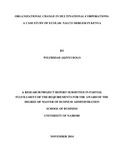| dc.description.abstract | Mergers and acquisitions are complex events in organizational life for which we have incomplete
understanding, in part because researchers have tended to consider only partial explanations of
them. The research establishes how sustainability of different cultures and functional processes
is a function of the similarity and complementarity of the two merging businesses (combination
potential), the extent of interaction and coordination during the organizational change process,
and the lack of employee resistance to the combined entity. The approach differs from
traditional methods of studying mergers and acquisitions in two ways: (1) the success of a
merger or acquisition is gauged by the degree of collaboration realization rather than more
removed and potentially ambiguous criteria such as accounting or market returns; (2) the key
attribute of combination potential is conceptualized not only in terms of the similarities present
across businesses, as in most studies of mergers and acquisitions, but also in terms of the
production and marketing complementarities between the two businesses. The basis of this
research will be to establish the influence of organizational change on multinational corporations
in Kenya with a focus on the factors they take into consideration before the change process and
their positions after the change, in this case the merger between Ecolab and Nalco. The purpose
of this research therefore will be to conduct a case study of Ecolab- Nalco merger in Kenya in
particular to try and understand the process of changing from a single MNC (only Ecolab) to
combined MNC (Ecolab and Nalco or other MNCs), understand the factors that drive MNCs to
merge and factors to be considered in order to achieve positive or successful results. In addition,
the study will seek to understand how change management in MNCs influences the pace and
direction of the globalization process, and how the key personnel is affected during the merger
process. The research shows that the main reasons for MNCs merging are profit, expansion,
market opportunity and to achieve growth. A review of the main theories covered in the
literature review, resource dependency theory and the theory of change shows that a mixture of
both of these theories (strong relationship between the two) is important when organizations
decide on what factors to consider in an M&A process. This is mainly because most of the
opportunities that are sought by both merging organizations will take advantage of the available
resources to achieve their intended strategic goals. The theory of change will also help such
organizations in outlining the necessary actions to take before, during and after the merger to
achieve positive results by clearly establishing the steps to undertake. The data will be collected
by conducting one- on- one interviews and qualitative method of data analysis used to analyze it.
From this research, we will realize that MNCs have a lot in common. Findings also suggest that
MNCs consider merging to utilize resources that an existing MNC may not have before the
merger, for example, Ecolab did not have an experienced work force in the Oil, Mine, Energy,
and Water sectors in Kenya before the merger, until the expatriates were brought. Other main
reasons for merging in MNCs are revenue growth, expansion/growth, market opportunity, and
shareholder motivation- what the shareholders believe will bring them the highest rates of
returns. In overall therefore, the findings provide strong support for an integrative/ resource
dependency theory of mergers and acquisitions. | en_US |

